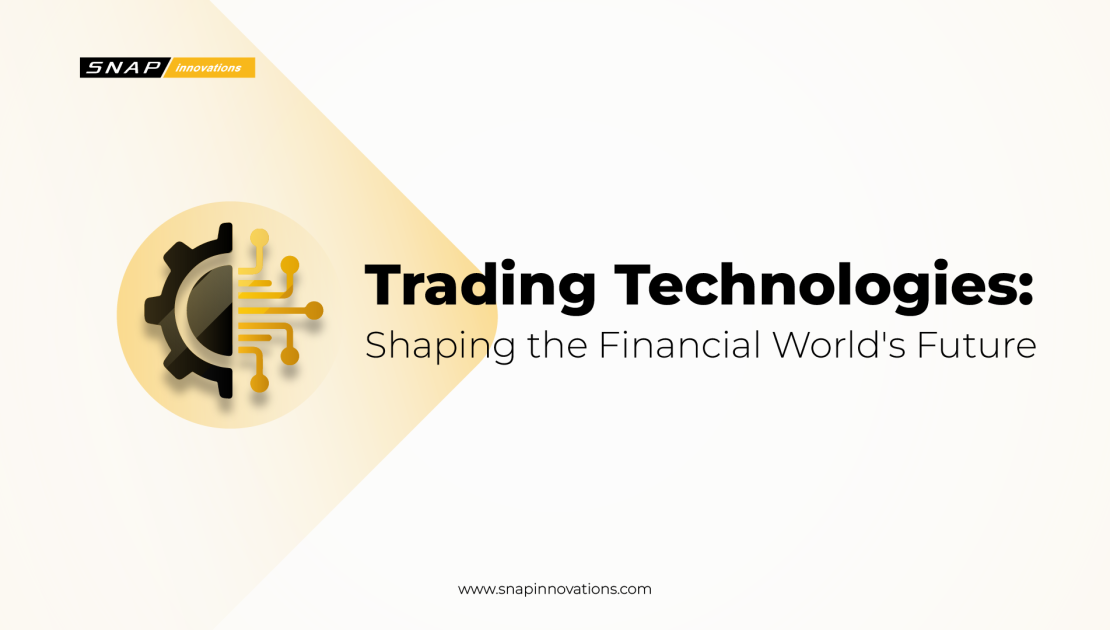In the ever-evolving world of finance, technology plays a pivotal role in shaping the way we trade and invest. One of the most transformative forces at work is Trading Technologies, a term that encompasses a wide array of innovative tools, platforms, and solutions designed to enhance the efficiency, accessibility, and effectiveness of trading in the financial markets.
Whether you’re a seasoned trader or a curious newcomer, this comprehensive guide will unravel the intricate web of Trading Technologies, shedding light on their significance, functionality, and the myriad ways they are revolutionizing the financial world.
What is Trading Technologies?
 At its core, Trading Technologies encompasses a diverse set of technologies and software solutions that empower traders and investors to execute financial transactions in a digital and automated environment.
At its core, Trading Technologies encompasses a diverse set of technologies and software solutions that empower traders and investors to execute financial transactions in a digital and automated environment.
This technological evolution has not only streamlined the buying and selling of various financial instruments, including stocks, bonds, commodities, currencies, and derivatives, with precision and speed but has also democratized access to financial markets. Online brokerages and trading platforms provide user-friendly interfaces, real-time data, and a wide range of financial instruments, making trading more accessible than ever before.
Read more: What Is NFT? Explore the World of Non-Fungible Tokens
Additionally, the rise of high-frequency trading (HFT) has introduced lightning-fast algorithms that execute trades within microseconds, contributing to market efficiency and liquidity. Trading Technologies have not only revolutionized the way we trade but have also ushered in an era where both individual investors and institutional giants can coexist and compete on a level playing field, transforming the financial landscape into a realm of unparalleled opportunity and accessibility.
The Evolution of Trading Technologies Platforms
The journey of Trading Technologies through the annals of financial history has been marked by a continuous evolution of trading platforms. This evolution has not only shaped the way we trade but has also redefined the very essence of financial markets.
1. Traditional Trading Floors
Traditional Trading Floors: Before the digital age, financial markets operated primarily on traditional trading floors, where brokers and traders would engage in open outcry trading. The iconic images of bustling trading pits, with traders shouting orders and waving their hands, were synonymous with financial markets.
These floors provided a tangible and dynamic environment for trading, but they were limited by physical constraints and required traders to be present at the exchange. The transition from traditional floors to electronic platforms represented a seismic shift in the financial world, enabling trading to occur beyond the confines of physical locations.
2. Electronic Communication Networks (ECNs)
Electronic Communication Networks emerged as a significant development in the transition from traditional trading floors to digital platforms. ECNs are computer-based systems that match buy and sell orders electronically.
They introduced efficiency, transparency, and accessibility by connecting market participants directly. With ECNs, traders could access a broader pool of liquidity, and the spread between bid and ask prices narrowed significantly. This development not only reduced trading costs but also paved the way for the globalization of financial markets, as traders from around the world could interact seamlessly on electronic platforms.
3. Direct Market Access (DMA)
Direct Market Access systems allowed traders to interact directly with financial markets, bypassing traditional brokers. DMA offered greater control and speed in executing trades, enabling traders to implement strategies with precision.
It empowered both institutional and retail traders to access markets directly, eliminating intermediaries and reducing the potential for order delays or errors. DMA became a game-changer in terms of democratizing access to financial markets, leveling the playing field for traders of all sizes.
4. Online Trading Platforms
The advent of the internet brought forth online trading platforms, which democratized trading by allowing individual investors to trade from the comfort of their homes. These platforms provided user-friendly interfaces, real-time market data, and a wide range of financial instruments.
Online trading became accessible to anyone with an internet connection, eliminating geographical barriers and opening up new horizons for traders. Online brokers offered a plethora of educational resources, enabling traders to learn and refine their strategies without the need for a physical presence on a trading floor.
5. Mobile Trading Apps
The subsequent wave of transformation came with the proliferation of mobile trading apps. Now, traders can monitor markets, execute orders, and manage their portfolios seamlessly using smartphones and tablets.
The portability and convenience offered by mobile trading apps have enabled traders to stay connected to the markets 24/7, further blurring the lines between physical and digital trading spaces. Mobile apps have become an integral part of traders’ toolkits, allowing them to seize trading opportunities from virtually anywhere in the world.
6. Algorithmic Trading
The rise of algorithmic trading, often referred to as algo-trading, represents another milestone in the evolution of trading platforms. This facet of Trading Technologies relies on mathematical models and computer algorithms to execute trades automatically.
These algorithms can analyze vast amounts of data, identify trading opportunities, and execute orders with precision and speed beyond human capabilities. Algorithmic trading has become a cornerstone of modern finance, used by both institutional and retail traders. It has not only increased the efficiency of trading but has also introduced a new dimension of quantitative analysis to the financial world.
7. High-Frequency Trading (HFT)
High-frequency trading takes algorithmic trading to the extreme, executing thousands of trades within fractions of a second. HFT firms leverage cutting-edge technology, co-location services, and low-latency connections to exchanges to gain a competitive edge. While controversial, HFT has become an integral part of financial markets, contributing to liquidity and efficiency.
HFT’s lightning-fast execution speeds have pushed the boundaries of what’s possible in trading, with strategies designed to capitalize on even the smallest market inefficiencies. It represents the pinnacle of technology-driven trading, where every microsecond counts in the quest for market advantage.
The evolution of trading platforms, from traditional floors to electronic interfaces, from desktop applications to mobile apps, and from manual execution to algorithmic precision, exemplifies the relentless pursuit of efficiency, speed, and accessibility that defines Trading Technologies in the modern financial world. These platforms have not only reshaped the mechanics of trading but have also opened doors to new opportunities and possibilities for traders of all backgrounds.
The Benefits of Trading Technologies
 Trading Technologies are the driving force behind a transformative shift in the world of finance, offering a multitude of advantages that have reshaped the landscape of financial markets. These technologies have been instrumental in enhancing trading efficiency, automating processes, and drastically reducing manual errors, thereby enabling traders to execute orders with remarkable speed and precision.
Trading Technologies are the driving force behind a transformative shift in the world of finance, offering a multitude of advantages that have reshaped the landscape of financial markets. These technologies have been instrumental in enhancing trading efficiency, automating processes, and drastically reducing manual errors, thereby enabling traders to execute orders with remarkable speed and precision.
Accessibility and inclusivity have flourished as Trading Technologies democratized finance, allowing individual investors to participate alongside institutional giants, effectively leveling the trading playing field. Real-time data and advanced analytics have ushered in an era of market transparency, providing traders with unprecedented insights and empowering them to make well-informed decisions.
Furthermore, the liquidity and price efficiency of markets have significantly improved under the influence of these technologies, benefiting all participants by reducing bid-ask spreads and mitigating price volatility. In essence, Trading Technologies represent not just a technological revolution, but a paradigm shift that not only makes trading more accessible and efficient but also transforms financial markets into a realm of greater fairness, transparency, and opportunity for all, ushering in an era where the power of technology and innovation is harnessed for the benefit of every participant in the financial ecosystem.
Tools and Resources for Trading Technologies
The toolbox available to traders is constantly evolving and expanding, offering a wide array of tools and resources to enhance decision-making, risk management, and strategy execution. Here are some additional components of the modern trader’s toolkit:
1. Trading Journals
Keeping a trading journal is a vital practice. It allows traders to track their performance, review past trades, and identify patterns in their decision-making. These insights are invaluable for continuous improvement.
Traders can use specialized journaling software or even create their custom templates to capture essential data. Comprehensive journals may include trade entry and exit points, reasons for each trade, emotional state, and post-trade analysis. Some journals also integrate with analytics tools to provide deeper insights.
2. Options and Derivatives Analysis Software
For traders delving into the world of options and derivatives, specialized analysis software provides tools to assess option pricing, conduct risk analysis, and construct complex options strategies.
These tools can model various scenarios and help traders make informed decisions in complex derivative markets. They often come equipped with Greeks calculations, volatility analysis, and scenario builders, enabling traders to navigate the intricacies of derivatives trading effectively.
3. Alternative Data Sources
In today’s data-driven world, alternative data sources, such as social media sentiment, satellite imagery, and economic indicators, can provide unique insights into market trends and opportunities.
Accessing and analyzing these sources can give traders an edge by uncovering hidden market dynamics that traditional data may not capture. Advanced tools offer data scraping capabilities and machine learning algorithms to extract actionable insights from alternative data. These tools may also integrate with data visualization platforms for easier analysis.
4. Advanced Charting Software
Advanced charting software goes beyond basic technical analysis tools. It offers features like custom indicators, advanced pattern recognition, and backtesting capabilities, enabling traders to visualize market trends and test their strategies rigorously.
These tools empower traders to make data-driven decisions based on comprehensive chart analysis. Some advanced charting platforms integrate with trading platforms for seamless execution, allowing traders to act on chart patterns directly.
5. Machine Learning and AI Tools
Machine learning and AI-driven trading tools are gaining prominence for their ability to analyze vast datasets, identify patterns, and even execute trades based on learned strategies.
Traders are increasingly exploring these cutting-edge technologies to gain a competitive advantage in today’s algorithmic trading landscape. These tools adapt and evolve with changing market conditions, utilizing neural networks and predictive modeling. They can provide personalized trading recommendations based on historical data and market conditions.
6. Community and Social Trading Platforms
Trading is not always a solitary pursuit. Community and social trading platforms allow traders to connect with peers, share insights, and even follow the strategies of experienced traders.
These platforms foster a collaborative approach to trading, where knowledge sharing and mentorship play a pivotal role in traders’ success. Some platforms also offer copy-trading features, enabling users to replicate the trades of top-performing traders. Advanced social trading platforms incorporate sentiment analysis and real-time collaboration features.
7. News Aggregators and Sentiment Analysis Tools
Staying informed about market news and sentiment is crucial. News aggregators that curate financial news and sentiment analysis tools that gauge market mood help traders make informed decisions in real time.
These tools enable traders to react quickly to breaking news and assess its potential impact on markets. Some sentiment analysis tools employ natural language processing and machine learning to extract sentiment signals from news articles and social media, providing a comprehensive view of market sentiment.
8. Cryptocurrency Exchanges
With the rise of cryptocurrencies, dedicated cryptocurrency exchanges provide a platform for trading digital assets. These exchanges offer a wide range of cryptocurrencies and trading pairs, catering to the growing interest in the crypto market.
Traders can access advanced trading features, such as margin trading and futures contracts, on these platforms. Additionally, cryptocurrency wallets and security tools are essential for safeguarding digital assets in the crypto ecosystem.
9. Trading Simulators
Trading simulators allow novice traders to practice their strategies in a risk-free environment. These tools replicate real market conditions, enabling traders to gain experience without risking capital.
Simulators are valuable for testing strategies, refining skills, and building confidence before entering live markets. Some simulators offer features like historical data playback and multi-asset trading simulation, allowing traders to simulate various market scenarios.
Developing a Trading Technologies Plan
 Developing a trading plan is a cornerstone of success in the world of trading, and it’s not a one-size-fits-all endeavor; rather, it’s a meticulously tailored roadmap that guides a trader’s journey through the tumultuous waters of financial markets. To embark on this crucial task, traders must first define their goals and risk tolerance, creating a clear vision of what they aim to achieve and how much they are willing to risk.
Developing a trading plan is a cornerstone of success in the world of trading, and it’s not a one-size-fits-all endeavor; rather, it’s a meticulously tailored roadmap that guides a trader’s journey through the tumultuous waters of financial markets. To embark on this crucial task, traders must first define their goals and risk tolerance, creating a clear vision of what they aim to achieve and how much they are willing to risk.
Also Read: Market Making Software: A Comprehensive Guide
This foundational step sets the tone for the rest of the plan, helping traders identify suitable trading strategies and asset classes. Market research becomes paramount, as traders delve into in-depth analysis to identify potential opportunities and risks. Armed with a thorough understanding of market dynamics, traders can then proceed to outline their trading strategies, which encompass entry and exit criteria, position sizing, and risk management rules.
These rules act as a compass, ensuring that traders stay on course and avoid impulsive decisions driven by emotions. In parallel, traders establish clear performance metrics and benchmarks to objectively evaluate their progress. Continual learning and adaptation are woven into the fabric of the plan, as markets are dynamic and ever-changing. Lastly, a trading plan is not set in stone; it evolves as traders gain experience and market conditions shift, requiring periodic reviews and adjustments. Ultimately, a well-crafted trading plan serves as a guiding light, helping traders navigate the complexities of the financial world with discipline, resilience, and a strategic edge.
Conclusion
In the ever-evolving world of finance, Trading Technologies stand as a testament to the relentless pursuit of efficiency, accessibility, and innovation. From the advent of electronic trading platforms to the rise of algorithmic and high-frequency trading, these technologies have redefined how financial markets operate.
They have opened doors for traders of all backgrounds, offering access to real-time data, advanced tools, and a wealth of educational resources. However, successful trading requires more than just technology; it demands a well-crafted trading plan, effective risk management, continuous learning, and a keen understanding of market analysis.
As we navigate the complex world of Trading Technologies, remember that it is the synergy of technology and strategy that can lead to success in the dynamic landscape of financial markets. So, whether you’re a seasoned trader or an aspiring investor, harness the power of Trading Technologies to transform your financial journey.


